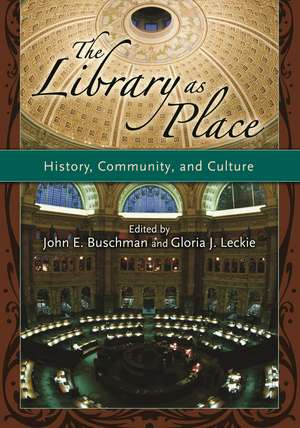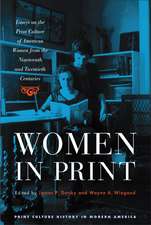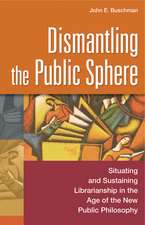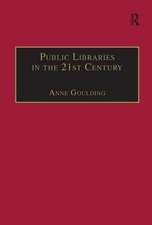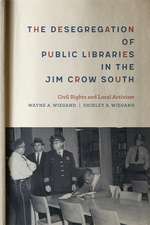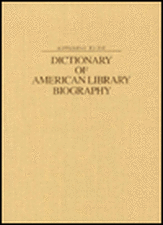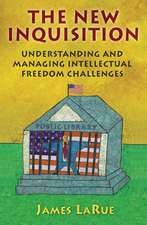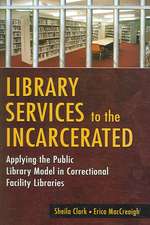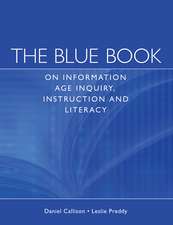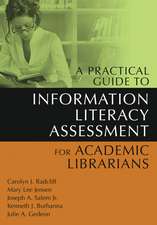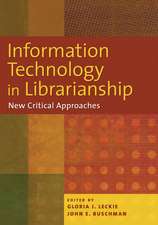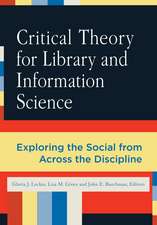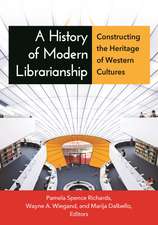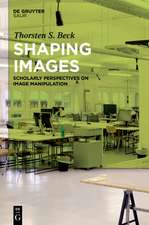The Library as Place: History, Community, and Culture
Editat de John E. Buschman, Gloria J. Leckieen Limba Engleză Paperback – 29 dec 2006 – vârsta până la 17 ani
Preț: 302.21 lei
Nou
Puncte Express: 453
Preț estimativ în valută:
57.84€ • 60.16$ • 47.75£
57.84€ • 60.16$ • 47.75£
Carte tipărită la comandă
Livrare economică 15-29 aprilie
Preluare comenzi: 021 569.72.76
Specificații
ISBN-13: 9781591583820
ISBN-10: 1591583829
Pagini: 268
Dimensiuni: 178 x 254 x 17 mm
Greutate: 0.55 kg
Editura: Bloomsbury Publishing
Colecția Libraries Unlimited
Locul publicării:New York, United States
ISBN-10: 1591583829
Pagini: 268
Dimensiuni: 178 x 254 x 17 mm
Greutate: 0.55 kg
Editura: Bloomsbury Publishing
Colecția Libraries Unlimited
Locul publicării:New York, United States
Notă biografică
John E. Buschman holds a B.S. in history and sociology and an M.L.S. - both from Ball State University, and an M.A. in American Studies from Saint Joseph's University. He has published two books: Dismantling the Public Sphere: Situating and Sustaining Libraries in the Age of the New Public Philosophy ( Libraries Unlimited 2003) and Critical Approaches to Information Technology in Librarianship: Foundations and Applications (Greenwood 1993). He is co-editor of the journal Progressive Librarian and on the editorial board of Library Philosophy and Practice.Gloria J. Leckie has an MLIS as well as an MA and PhD in Geography from the University of Western Ontario. Her research interests include information-seeking behavior, the work of scholars and professionals, academic librarianship, information literacy and libraries as public space. Gloria is currently on the Board of the Association for Library and Information Science Education, as well as on the Editorial Boards of Library Quarterly and the Canadian Journal of Information and Library Science.
Cuprins
Foreword by Wayne A. Wiegand and John Carlo BertotIntroduction1. Space, Place, and Libraries: An Introduction Gloria J. Leckie and John E. BuschmanSection I: The Library's Place in the Past2. Beneficial Spaces: The Rise of Military Libraries in the British Empire Ronald Tetreault3. Libraries in Public before the Age of Public Libraries: Interpreting the Furnishings and Design of Athenaeums and Other "Social Libraries," 1800-1860 Adam Arenson4. A Grand Old Sandstone Lady: Vancouver's Carnegie Library Ann CurrySection II: Libraries as Places of Community5. The Fruit and Root of the Community: The Greensboro Carnegie Negro Library, 1904-1964 Julia A. Hersberger, Lou Sua, and Adam L. Murray6. Locating the Library as Place among Lesbian, Gay, Bisexual, and Queer Patrons Paulette Rothbauer7. Behind the Program-Room Door: The Creation of Parochial and Private Women's Realms in a Canadian Public Library Pamela J. McKenzie, Elena M. Prigoda, Kirsten Clement, and Lynne (E.F.) McKechnie8. Seattle Public Library as Place: Reconceptualizing Space, Community, and Information at the Central Library Karen E. Fisher, Matthew L. Saxton, Phillip M. Edwards, and Jens-Erik MaiSection III: Research Libraries as Places of Learning and Scholarship9. Stimulating Space, Serendipitous Space: Library as Place in the Life of the Scholar Karen Antell and Debra Engel10. Setting the Stage for Undergraduates' Information Behaviors: Faculty and Librarians' Perspectives on Academic Space Lisa M. Given11. The Research Library as Place: On the Essential Importance of Collections of Books Shelved in Subject-Classified Arrangements Thomas MannSection IV: Libraries, Place, and Culture12. On the Myths of Libraries Bonnie Mak13. Managing Pleasure: Library Architecture and the Erotics of Reading Abigail Van Slyck14. Going to Hell: Placing the Library in Buffy the Vampire Slayer Adriana EstillIndexAbout the Editors and Contributors
Recenzii
There is something here for most readers. Those with an interest in historic libraries, library architecture and furnishings, libraries as community centers, and libraries as an idea will find something both enjoyable and enlightening in this collection.
The Library as Place would be a fitting addition to a library system's professional collection or an academic library.
Library as Place: History, Community, and Culture features 14 papers that examine the library as a physical, social, and intellectual space. This is an eclectic collection, ranging from a history of the establishment of far-flung military libraries during the heyday of the British Empire (to instill sober, regular, and moral habits among the troops) to an analysis of the function of the Sunnydale High School library in Buffy the Vampire Slayer. It's thought-provoking--the next time I visit my local library, I'll go with a perspective beyond just browsing the new-fiction shelves.
A well-chosen compilation of library scholarship; as always with such things some pieces are far more interesting than others, but for those whose interests run to deep discussions of library philosophy, this book's for you.
In this collection of 14 original papers contributors analyze the cultural, symbolic and intellectual meanings of library spaces of all sorts, ages, compositions and aspirations. Papers cover libraries of the past, including the military libraries of the British Empire, the private libraries of the early nineteenth century, and the Carnegie libraries; libraries as places of communal experience, as in a black community before civil rights, for women seeking public lives, for sexual minorities or for those seeking an information community; as places of learning and scholarship as serendipitous space for scholars and goads for undergraduates; and as elements of culture as places of pleasure or imagination, as in the hellish library of Buffy the Vampire Slayer.
The Library as Place would be a fitting addition to a library system's professional collection or an academic library.
Library as Place: History, Community, and Culture features 14 papers that examine the library as a physical, social, and intellectual space. This is an eclectic collection, ranging from a history of the establishment of far-flung military libraries during the heyday of the British Empire (to instill sober, regular, and moral habits among the troops) to an analysis of the function of the Sunnydale High School library in Buffy the Vampire Slayer. It's thought-provoking--the next time I visit my local library, I'll go with a perspective beyond just browsing the new-fiction shelves.
A well-chosen compilation of library scholarship; as always with such things some pieces are far more interesting than others, but for those whose interests run to deep discussions of library philosophy, this book's for you.
In this collection of 14 original papers contributors analyze the cultural, symbolic and intellectual meanings of library spaces of all sorts, ages, compositions and aspirations. Papers cover libraries of the past, including the military libraries of the British Empire, the private libraries of the early nineteenth century, and the Carnegie libraries; libraries as places of communal experience, as in a black community before civil rights, for women seeking public lives, for sexual minorities or for those seeking an information community; as places of learning and scholarship as serendipitous space for scholars and goads for undergraduates; and as elements of culture as places of pleasure or imagination, as in the hellish library of Buffy the Vampire Slayer.
